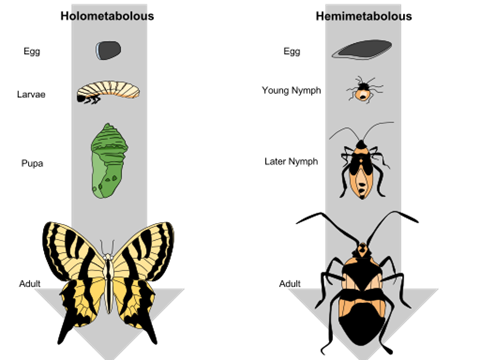- Science
- Grade 3
- Organisms and environments
Science.3.13.B
explore, illustrate, and compare life cycles in organisms such as beetles, crickets, radishes, or lima beans.

Knowledge and Skills Statement
The further explanation is designed to be a resource for educators that helps them better understand the topic their students are learning. Further explanations may be written at a more complex level than would be expected for students at the grade level.
Some insects go through complete metamorphosis, where young do not resemble their parents until adulthood. (See the image on the left.) Complete metamorphosis consists of four distinct stages in which the insect continues to grow and change during each stage: egg, larva, pupa, and adult. For example, ladybird beetles, darkwing beetles, and monarch butterflies undergo complete metamorphosis.
Some insects go through incomplete metamorphosis, where the young resemble their parents once hatched from the egg. (See the image on the right.) Incomplete metamorphosis consists of three stages in which the insect continues to grow and sheds its exoskeleton: egg, nymph, and adult. For example, crickets, roaches, and lice undergo incomplete metamorphosis.
Research
Cavallo, Ann. 2005. “Cycling Through Plants.” Science and Children 42, no. 7 (2005): 22–27. http://www.jstor.org/stable/43172521.
Summary: Students may need help understanding the relationship between seeds and plants. In this article, 3rd-grade students explore seeds, such as lima bean or string bean seeds, monitor plant growth, and observe sprouted seeds to learn how seeds grow into plants. Students start by looking at seeds using tools like magnifying glasses. They record drawings and observations using kid-friendly language that they are familiar with. They dissect their seeds to see what they look like on the inside. After this exploration, the teacher introduces scientific vocabulary. Next, students put seeds in plastic bags with water to observe changes in their seeds. They record observations daily and notice what changes they are seeing. Children can then compare new and sprouted seeds to see the similarities and differences. Students end the activity by making predictions about what plants need to grow.
Research
"Keeley, Page. 2018. “Formative Assessment Probes: Uncovering Representations of the Water Cycle.” Science and Children 55, no. 5 (January 2018): 18-19.
http://www.jstor.org/stable/44709896. "
Summary: Learning about life cycles can help students understand the continuity of life, but students need to know that life cycles look different depending on the organism. Many young students start learning about life cycles by observing and describing the parts of the life cycles of organisms that experience a complete metamorphosis, like butterflies. Students can then describe the different phases these organisms go through during their life cycle. They can start to believe that only organisms that experience dramatic phase changes (like frogs or butterflies) experience life cycles rather than all living things. Learning life cycles only through complete metamorphosis can cause students misconceptions. Collaborative discussion among students is essential in correcting these misconceptions. Teachers can discuss organisms using picture cards for younger grades, and students can decide together whether or not they think that organism experiences a life cycle and give their reasoning for why or why not.

